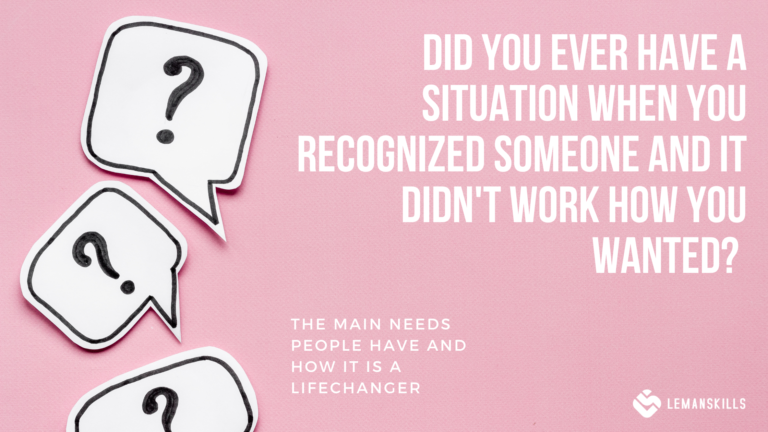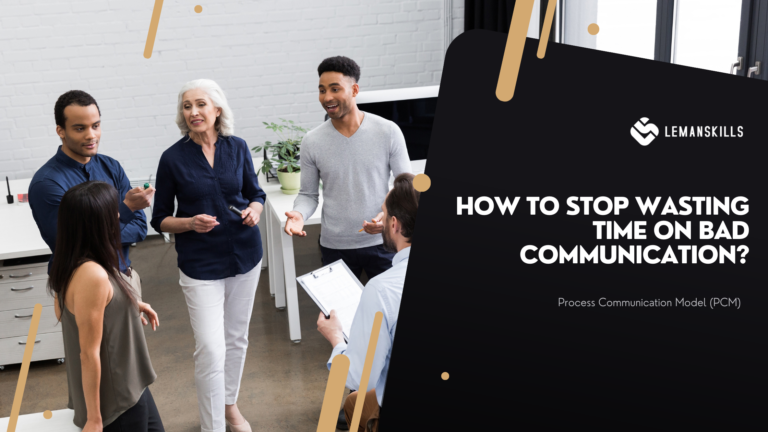
Process Communication Model (PCM): Main Psychological Needs
In the first article, I mentioned a few elements about the framework of Process Communication Model (PCM) and I’ve shared how much it changed the way I look at the communication itself, but also at differences (and similarities) that we have as people. It appeared that even if you know a lot of things, you can always learn something that can be a groundbreaking experience for you. And what can change the way you think about yourself and the world that is around you. What stopped me when I’ve started learning about PCM was many different elements of it that create the whole puzzle which describes the while structure of peoples’ personalities. And what’s inside of this: behaviors, the ways of reacting in certain situations (in a reaction for a certain stimuli or trigger), their preferences regarding the way they communicate, but also the way they want to receive communication from others. One of those elements that are extremely important in PCM’s structure are main psychological needs. What are they for each of 6 types of personality? Why we even talk about them? What happens when they are not covered? Let’s dig deeper into that space today. What Are the Main Psychological Needs in PCM? Each of 6 personality types in PCM has their own psychological need or needs. It is one or two the most important things that they seek to cover to feel balanced and to not go into distress. Meaning: if the main psychological need(s) is/are safe, a person is in a good shape and has access to their resources to make good decisions or solve problems in an optimal way. You can find below the structure way of those needs. Recognition of work means that the value that Persister and Thinker bring to the table in a work environment is visible and appreciated by others. Hard work, quality and time they’ve invested into a certain thing is worth the outcome and important for others who recognize that. Recognition of convictions for Persister means that what they value and that kind of beliefs and opinions they have regarding certain thing are meaningful for others. Time structure for Thinker means that there is an order of their structure of day, rituals, tasks they cover during the day (private and/or personal). It can be a structure around work/goals that are on the list for a week or month. The key here is to have everything in place, with a space to adapt it, if needed. Incidence for Promoter exists when things are happening. There is action, excitement brought by successfully delivered tasks, projects, achieved goals or key milestones on a path they follow. Being in contact for Rebel is a key thing since they need other people, space to discuss things, like or dislike them together. They need to have an external source of energy, making them feel that they have connection with the world that is around them. Recognition of person is quite different from recognition of work that was mentioned for Persister and Thinker. Recognition of person means that Harmonizer is seen as a person. That it’s good that they are there, they bring value to others by their existence. They are an important key player in the team. Because Harmonizers are using all their senses to experience the world that is around them, sensory is one of their main needs. It means that they need to have visuals (i.e., colorful spaces or art around them), sounds (may be different in terms of individual preferences), smells (like fresh bread, paint or grass), something they can touch (like nice fabric textures of furniture). It’s about feeding the senses they use to experience the reality. Solitude for Imaginers is a space where they can reflect on all those things that are in their heads. It doesn’t mean that they want to be alone all the time: it means that they need space, time and (most of the time) silence to recuperate and make space for their brains to work properly. What Happens When the Needs Are Not Covered? Once we know who we are and who are people that are around us (our children, significant other, friends, coworkers or direct reports), we have a ready solution to work with them. Your child is a Thinker? Give them recognition sign every time when they do something good in a workspace area (it can be about cleaning up their room or doing their homework). Your employee is a Harmonizer? Sit with them in a nice, colorful, closed room, give them a hot tea in a ribbed cup and say that it’s good to see them and have them in the team. But if you have a partner who is a Persister and you say to them after a great speech that they’ve just delivered that they look pretty, guess what happens? They can start feeling frustrated, since they’ve got not the right recognition (they seek for recognition of work, but they’ve got a recognition of person). Your intention was good, so you can be surprised that the reaction is not like you aimed for. The key thing here is to understand that it’s not about you: it’s about their need that was not fed in a right way. So, what happens when those main psychological needs are not covered properly? The person goes into distress. Meaning: they go and act not from their resources, but from their driver behavior. They might seem irrational, not accepting other peoples’ mistakes or closing themselves and doing everything on their own. Depends on the driver a certain person has and what happens with them in distress zone. The point is: when basic psychological needs are not fed, a person is not in contact with themselves, not making optimal decisions, might feel like they are not the best version of themselves. They might make mistakes, be sloppy, forget things, being mean, acting scared or resist all the time. A behavior depends on a person, but

